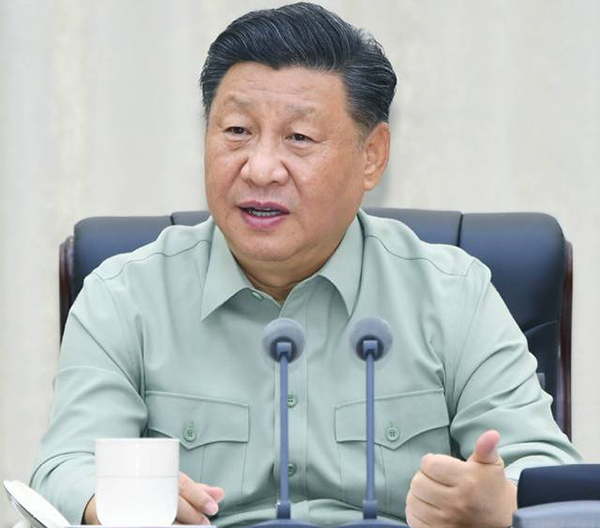Chinese President Xi Jinping, on his visit to the headquarters of the Marine Corps, told the Chinese military to stay on “high alert” and “focus their energy on preparing for war”, according to state news agency Xinhua as reported by CNN. However, it was not clear if Xi’s remark was directed towards India, with which, China has been having border disputes for quite some time now.
Xi, who is Chairman of the Central Military Commission (CMC) – the overall high command of the military, besides being the President and the General Secretary of the ruling Communist Party – inspected the People’s Liberation Army (PLA) Navy-Marine Corps in Chaozhou, south China’s Guangdong Province on 13 October 2020.
Xi spoke to high-ranking navy officials during the visit to Chaozhou, as part of his plans to deliver a commemorative speech marking the 40th anniversary of the Shenzhen Special Economic Zone on the border with Hong Kong on 14 October. Special focus on the commercial and technology hub is expected to send a strong signal to Hong Kong-marred by recent protests over China’s new security law-about the benefits of operating under a Beijing mandate.
In his interaction with the Marine Corps commanders, Xi asked them to “concentrate on fostering their troops for combat preparedness” and stay on high alert. “More realistic battle training must be carried out to enhance skills and more efforts should be made to innovate in terms of combat theories, training methods, and task planning”, Xi reportedly said.
Military Reforms
Xi also called for closer cooperation with other branches of China’s armed forces in order to “fully integrate” the Marine Corps into a joint operations system.
This was Xi’s first visit to the headquarters of the Marine Corps, which was overhauled in 2017 and became part of the PLA Navy during the military reforms launched by him in 2015. He stressed that the Marine Corps was an elite amphibious fighting force that shoulders significant responsibilities in safeguarding national sovereignty and territorial integrity as well as China’s maritime rights and overseas interests.
ALSO READ: Troubles Mounting for Xi Inside China
Under the reform, the PLA slashed three lakh troops from the army and focused expansion of navy and the air force as part of China’s efforts to enhance its global influence. In 2017, the Hong Kong-based South China Morning Post reported that China plans to increase the size of its marine corps from 20,000 to one lakh personnel for overseas deployment including Gwadar port in Pakistan and military logistics base in Djibouti in the Indian Ocean. The expansion is planned to protect China’s maritime lifelines and its growing interests overseas, the report said.
Xi’s reforms have also created a top-down model wherein he personally controls all power to declare war, deploy troops and decide the promotion of senior officers. His one-man rule will weaken the institutional oversight of the armed forces. Too much centralisation of authority will erode professionalism.
The Chinese president’s rallying cry came at a time when the Chinese navy was carrying out live fire drills in the East China Sea, seemingly rehearsing for a potential invasion of Taiwan. The self-ruled island of around 24 million people, which China views as a breakaway province, responded with its own anti-landing exercises off its western coastline.
In early 2014, Xi took over the chairmanship of a leading group on military reforms and declared that the country’s overriding goal was to produce a military that could ‘fight and win battles’. During the civil war (1927-49), China’s People’s Liberation Army (PLA) was essentially a guerrilla force used by Mao Zedong to fight against the Kuomintang troops led by Chiang Kai-shek and those of the Japanese empire.
Xi had an ambitious vision for China’s rejuvenation, including the restoration of its ‘great power’ status. He realised early that in accomplishing this task, the modernisation of its armed forces would play a key role. After a thorough study and assessment, Xi announced a series of major organisational changes in late 2015. Seven military regions were restructured into five theatre commands (TCs) aligned against regional threats. Each TC was equipped with its own package from the army, air force, navy and conventional missiles. The PLA headquarters was given the responsibility to ‘organise, train and equip’ missions and their operational responsibility was devolved to the TCs.
In October 2017, the size of the CMC, the apex administrative body, was reduced from 11 to seven members. The service chiefs were excluded from the CMC to whittle down their powers. Two former members of the CMC, appointed during the years of former President Hu Jintao – Fang Fenghui and Zhang Yang – were removed on charges of corruption. A director of political work and a secretary of the discipline inspection commission were appointed to the CMC to signal the high importance attached to ideological indoctrination, subordination of the armed forces to the Chinese Communist Party (CCP) and enforcing strict discipline.


















